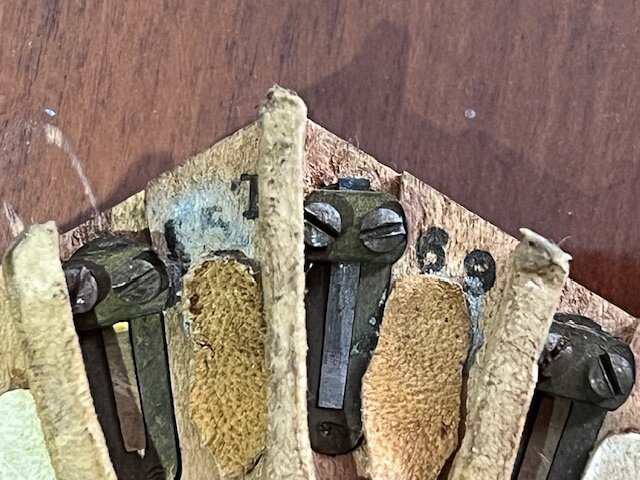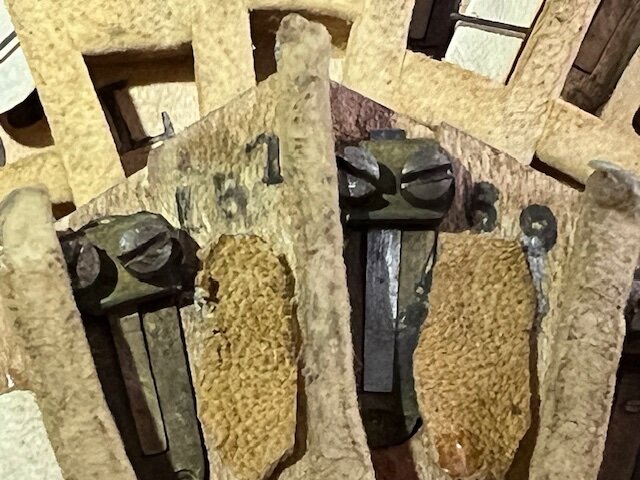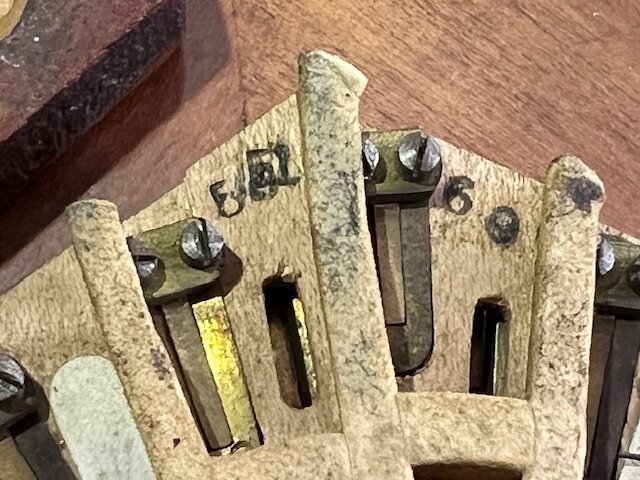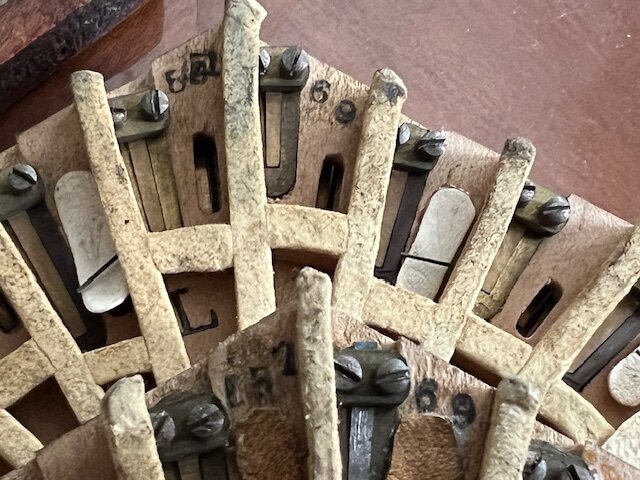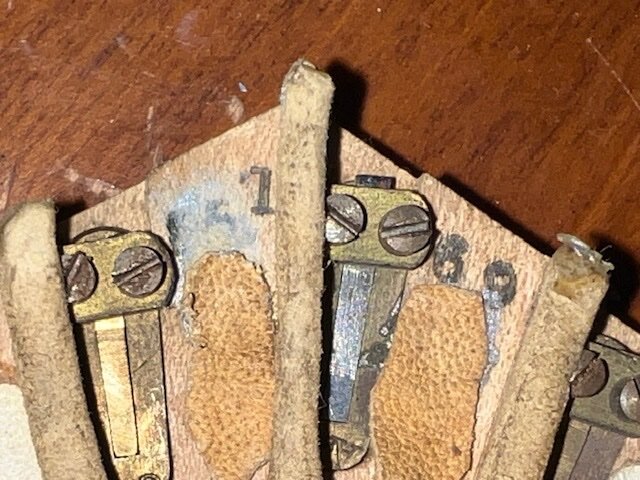-
Posts
296 -
Joined
Everything posted by 4to5to6
-
Does anyone have a source for a 43 tpi die, that cuts a 0.081 outer thread diameter on a 0.088 shaft? Overall total bolt length is 2.22 inches. I was told these are 5BA threads on a smaller 8BA shaft if this helps. I have offered to build a few end bolts for a large bass to help someone out. Thanks . Note: Actual specs are 43TPI on a 0.086 shaft - see page 3
-
Wow! Very nice concertina. I hope you will keep it and play it.. I love the mellow but clear sound of these early steel reeded instruments. A pleasure to play late in the evening. Sure, it doesn’t have the long scale reeds like the newer (100 year old) Aeolas but Regondi / Blagrove / Case used them and no one today that I know of can play anywhere close to the way these gentlemen did. I have a similar 1856 12.12 in mint condition previously owned by the Bulteel family (serial number sandwiched between a Regondi and a Blagrove purchase) that is one of my most prized instruments. Looks like a very fine vintage instrument. A work of art! Condition the bellows with some sparingly use of Connolly Hide Care on the gussets and hinges so they don’t crack. Wonderful! 700 to 2500 USD resale value depending on how it plays and level of restoration.
-

F Tenor conversion - Why D# to Db?
4to5to6 replied to 4to5to6's topic in Instrument Construction & Repair
Only somewhat true. Agree... All true trebles (treble, model 14 baritone treble, model 19 tenor treble, also G Bass) have the middle C on the LH compared to a true baritone (also piccolo) with the middle C on the RH side). Disagree… The C is not always centred with the thumb strap on tenors and can be shifted up or down a row as the two tenors shown in the photos above demonstrate. All of my trebles and tenor trebles have the LH middle C centred on the thumb strap. My Lachenal baritone has the C lined up with the middle of the LH thumb strap as well but this is not a set in stone rule especially for extended range trebles. My model 14 BT has the buttons shifted up a row. This is a rare model (a purple unicorn) but Geoff Woof has the same one, with the same layout, so I know it was designed this way. His has an extra long pinky slide by the way to make it more interesting. I don’t use the pinky slide as I follow the early (Blagrove) method of one finger per row so not sure how this affects things. Not completely sure why the shift up or down of middle C row, thumb straps / button position on the instrument / extra long pinky slides, etc. all in regards to the centre line and to each other but it is possible that the physical balance of the instrument while playing standing up was the determining factor in all of this. . -
Thank you. I am extremely priveledged and constantly feel honored to have a 31xxx 1926 Amboyna, gold fittings TT Aeola under my care. It took me 10 years to find such an instrument and have had it for about a year now. It is in near mint condition with only some minor honest playing wear, clean inside and out and never abused. In all the reed scale studies I have done on various Whearstone tenor trebles, this one is as close to perfect as they come. The reed gap clearance workmanship and scaling curve design are near perfect. It was already restored when Steve got it a few years ago but he restored it again. The setup and voicing he did is amazing and you can tell when playing it. Superior responsiveness, dynamics, balance and expression first come to mind. I can play music on this Aeola that I can’t on any other. It is a joy to play. And it looks awesome too 😊. I hope the one you are building with him turns out just as good. I am sure it will. .
-
Wow! Is this like a Sid Watkins -> Steve Dickinson -> Jake Middleton-Metcalfe kind of thing? Steve is so amazing and knowledgeable. I’ve learned do much from him myself… thread pitch for a concertina bolt, why only chambers on the inside, chamber harmonic dampening, tuning, reed profiles, reed scaling, button height, wood selection… more and more and more. What a privilege it would be to work close with him like this! All the best! .
-

Key-layout for a tenor-treble English Concertina
4to5to6 replied to Abel Miser's topic in Instrument Construction & Repair
PM me your email address and I will send you a nice image and pdf of a CAD drawing I did up. -
Yes, that’s too bad… I need a few end bolts and a couple of riveted reeds and some buttons. Some projects have bern on hold for years. I just bought a small lathe that will do threads so need to figure end bolts out. The same thing with the riveted reed shoes. Especially the ones with a flared slot. How did they do it??? I’ve always heard that “Necessity is the mother of invention.” so we all just need to figure it out. I don’t have a choice if I’m going to play and restore vintage instruments. There are many other ways to tune reeds other than with a bellows. There are a lots of YouTube videos with samples. Hopefully we can all share resources to help one another. Could c.net add a separate “Spares” wanted / for sale category? We’ll work it out. .
-

F Tenor conversion - Why D# to Db?
4to5to6 replied to 4to5to6's topic in Instrument Construction & Repair
Both are 48 button tenor (tenor treble) Aeolas. Button arrangements are the same but one has the thumb straps shifted and extra long pinky slides. Please see above discussion. -

F Tenor conversion - Why D# to Db?
4to5to6 replied to 4to5to6's topic in Instrument Construction & Repair
My rare model 14 has 56 buttons with range from G2 to G7, 4 octaves is like a tenor treble except a row is taken off the top and an extra lower row added on the bottom. G to G. The middle C is on the LH side just like a treble or TT so the fingering is NOT reversed like a baritone. However, it is usually still referred to as a Baritone Treble like the other extended baritone instruments. Based on the description above, as it does not have the full treble range then it should be called a baritone tenor. However, most Baritone trebles have the middle C on the RH side (fingering reversed so you can easily play an octave lower with treble fingering) like a baritone. So shouldn’t these instruments be called a Treble Baritone (reversed)? It also gets confusing with a C bass and the lower G bass when combined with an extended range. Many should be called Bass Baritones not Barritone Bass as the higher ranges are reversed like a baritone. The other factor that comes into this, which I originally asked above, and that is not at all obvious in the Wheatstone Price lists is the location of the C button to the thumb strap. Traditionally middle C lines up with the center of the LH thumb strap as with a treble, tenor treble, etc. but not always. Many times the C button is shifted up or even down a row especially with tenor style instruments as shown in the Crabb and Wheatsone photos above. When the middle C is on the RH side, then it should always be called Baritone in my opinion. Interesting discussion. I’m not sure this will ever be standardized in modern times as reference will always be made to the Wheatstone price lists which are inconsistent. . -

F Tenor conversion - Why D# to Db?
4to5to6 replied to 4to5to6's topic in Instrument Construction & Repair
I’ll draw up a button layout tomorrow and attach it. This should explain all. -

German Silver sheet for making new metal ends
4to5to6 replied to Alex West's topic in Instrument Construction & Repair
Where did you order the Nickle silver from if it’s okay to ask? -

F Tenor conversion - Why D# to Db?
4to5to6 replied to 4to5to6's topic in Instrument Construction & Repair
Thanks for the photos John. Very interesting. Do you agree then that the Crabb tenor would of been better suited as a F tenor? -

F Tenor conversion - Why D# to Db?
4to5to6 replied to 4to5to6's topic in Instrument Construction & Repair
Regarding 48B Tenor thumb strap placement in relation to middle C… It’s come to my attention that many 48 key tenors have been converted to F tenors (swapping the B and Bb reeds and tuning the D# down to Db) due to the middle C placement in relation to the thumb strap. It seems that tenors are designed with the buttons shifted up one row so dropping them down to F will bring the root note in line with the thumb strap like most trebles, TT, etc. I am hoping that someone with a tenor can verify this for me. Why does Wheatstone shift the buttons up a row in a tenor? -
I have one of these made by Bill Crossland. He included two reed openings instead of one so I could use it for tuning larger reeds. I like it
-
Best wishes on your retirement. Thanks for openly sharing your concertina knowledge.
-
I just sold my model 22 locally about 2 months ago. It was my first really good concertina and an amazing unique instrument. It was super loud with short fast action. Not shrill or harsh and still fairly good dynamics but unbelievably loud. It was hard to let it go but I can't keep them all. I never could fully understand why this model is so loud and fast but know they were designed this way. 1922 price list description: 22. Best nickel-plate Raised Ends, spherical end silver keys and finger plates to match, best steel vibrators, Morocco leather five-fold bellows, keys and tops bushed, new improved action, short touch and rapid articulation. Powerful tone 17-0-0 ( An Aeola treble was 18-0-0) Wh-Pricelist-Eng-c1920.pdf (concertina.com) I highly recommend the Wheatstone model 22. .
-
Wow! Very nice!
-
I have one of these riveted reed instruments. It is a Cramer Co., Richard Blagrove Select. It is fully playable as I recall but in old high pitch and basically unrestored. Not sure if I want to part with it as I am a huge Blagrove fan but if you really want or need it then I will let it go. Why the interest in such an old instrument? Here's a similar one in the Concertina Museum: The Concertina Museum Collection Ref:C-269.
-

Dating A Lachenal From The Serial Number
4to5to6 replied to johnconstable's topic in Concertina History
Please see attached photos… Is this 15769 or perhaps 55769? It is an early Lachenal treble that was modified with carved bone ends. It would be nice to know the serial and date. There are no other serial numbers except these two in the reed pans. -

Dating A Lachenal From The Serial Number
4to5to6 replied to johnconstable's topic in Concertina History
Thank you Wes! . -

Dating A Lachenal From The Serial Number
4to5to6 replied to johnconstable's topic in Concertina History
Can you please give me the approx date for Lachenal 184566, 20 button Anglo? It’s in very nice condition with the original leather baffles still installed (therefore makers badge and serial). In spite of all my efforts, two end bolts broke on disassembly but I can easily replace these. I really don’t think this concertina has been taken apart in 100 years!!! -
Yes. The ledger photo in the first post says “gilt fittings”. They are gold plated brass.
-
Wow! Someone did take a risk. Let’s hope it turns out to be a fine instrument. I can’t find the list now, but I went through all the ledgers before purchasing my 31xxx golden era amboyna model 19 TT and there were less than 40 made as I recall. The instrument cost me an arm and a leg but I do believe along with others that it could be one of the finest vintage concertinas in existence. It was well taken care of for its entire life based on its very clean condition and then meticulously restored and tweaked by a few of the best of the best including Steve Dickinson. I also have an exceptional 1856 Regondi / Blagrove era treble previously owned by the Bulteel family (Lord Revelstoke) and an Aeola treble built in 1942 during WWII (factory A440 with a factory 8-fold bellows) that is an exceptionally fine instrument with amazing reeds but they too are in absolutely pristine clean condition almost as new. They started out as top tier instruments and were always taken care over. .





